For
information on how to attain the Advanced TIP TIG Process,
contact Ed Craig
in the USA at 828 658 3574. E-Mail ecraig@weldreality.com
June
11 2009. Welcome to ADVANCED TIP TIG:
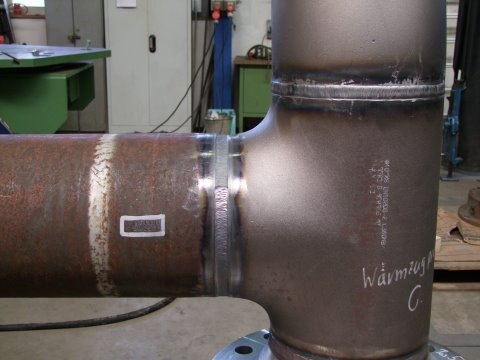
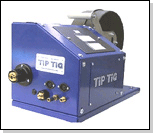
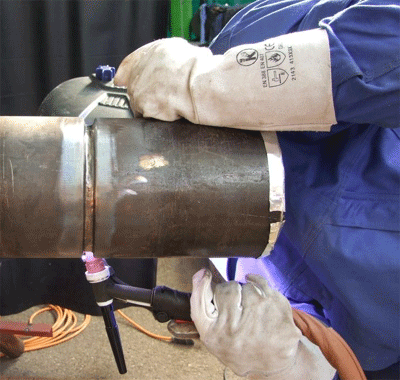
THE
2009. PATENT PENDING, ADVANCED
TIP TIG, IS THE WORLD'S
MOST EFFECTIVE WELD PROCESS FOR DELIVERING DEFECT
FREE WELDS
THE
ADVANCED TIP TIG PROCESS IS A SEMI-AUTOMATIC
AND AUTOMATIC ADVANCED TIG /
PLASMA WELD PROCESS.
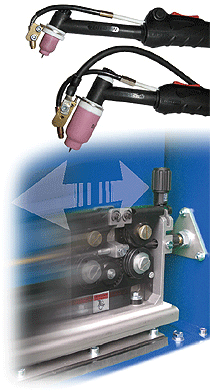 Take
a MIG wire and automatically feed that wire in a controlled manner at typical
wire feed rates of 1 to 12 meters per-minute into a high amp TIG or plasma arc.
Then apply a unique, patented, dynamic wire feed action that alters the weld's
surface tension, influencing the weld profile and weld solidification. Combine
those features with some unique customized equipment, and you have the patent
pending Advanced TIP TIG (ATT) process.
Take
a MIG wire and automatically feed that wire in a controlled manner at typical
wire feed rates of 1 to 12 meters per-minute into a high amp TIG or plasma arc.
Then apply a unique, patented, dynamic wire feed action that alters the weld's
surface tension, influencing the weld profile and weld solidification. Combine
those features with some unique customized equipment, and you have the patent
pending Advanced TIP TIG (ATT) process.
DEFECT FREE WELDS. The ATT process
will produce many remarkable weld benefits for any weld shop and the most important
benefit for any weld organization will be, this easy to use, moderate priced process
can deliver manual or mechanized weld quality never before attained in the global
welding industry. The goal of attaining cost effective welds at defect free, weld
quality levels that will consistently pass any NDT or weld test requirements,
should be the goal of any organization that deals with code quality welds.
PROCESSES
AND CONSUMABLES CAUSE WELD REWORK. As most weld shops are aware, the common weld
processes and consumables used in their shop will when used for all position welds
be part of the root cause of the weld defects that will require in costly weld
rework. In contrast to Stick - Traditional TIG - Plasma - MIG - Pulsed MIG - STT
- RMT - CMT or the Flux Cored process, the easy to use ATT process will always
produce superior weld quality, all position welds with cost effective MIG
and flux cored wire feed rates.
WELD PROCEDURES, SIMPLICITY WITH THE HIGHEST
QUALITY: Think about the complexity involved in a weld shop when developing traditional
pipe weld procedures using MIG Short Circuit - MIG Spray - MIG Globular - MIG
STT - MIG RMD - MIG CMT - Gas Shielded Flux Cored combined with traditional TIG
and SMAW. The weld reality with the ATT process is this. With ATT, two simple
wire feed and amp weld settings will be all the weld shop will need to attain
defect free welds on any all position application or on any weldable material.
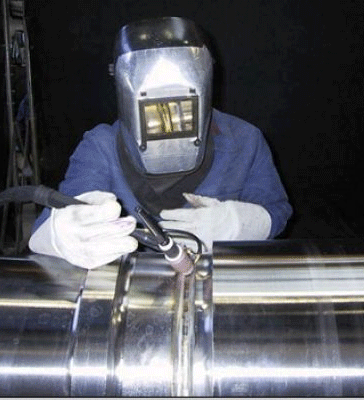 This
manual ATT Inconel 625 weld was deposited at 8 - 10 lb/hr.
This
manual ATT Inconel 625 weld was deposited at 8 - 10 lb/hr.
It's impossible
with either pulsed MIG, flux cored or traditional TIG or plasma to duplicate the
weld quality or the weld cleanliness that was attained from this ATT weld. As
the ATT wire feed is constant and always fed into an exact optimum position in
the arc zone, the welder can use one hand for the welds, or use their free hand
to guide a torch. The ATT torch is much lighter than the typical MIG or flux cored
gun. One weld pass or a 100 weld passes, the ATT process was developed to consistently
produce cost effective, defect free welds.
With the ATT process, it does
not matter what the application the weld position or the alloy to be welded is.
Carbon steels, stainless, aluminum, Inconel, titanium, hastelloy, stellite, duplex,
low and high alloys, tool and cast steels welds and cladding. No other global
manual or automated weld process delivers such a unique combination of real world
weld benefits.
ATT provides all position weld deposition rates equal to
pulsed MIG and weld quality and mechanical properties always superior to what
was the traditional manual TIG and Plasma processes. When defect free welds are
important to your organization or you need an easy to use process for all position
pipe welds, this process will provide your weld shop with good weld deposition
rates, defect free welds, no weld smoke issues, no spatter issues, narrow heat
affected weld zones and minimal weld distortion.
ADVANCED TIP TIG is a unique TIG or Plasma weld process that
will consistently produce higher weld quality and productivity than conventional
manual TIG / Plasm, or the automated Hot Wire TIG and the Plasma processes.
IT'S
WELD QUALITY WITH WELD PRODUCTIVITY: Not only does the ATT process produce
superior manual / automated weld quality than any other process, it can provide
the weld, clad or braze quality at pulsed MIG and flux cored weld deposition rates.
|
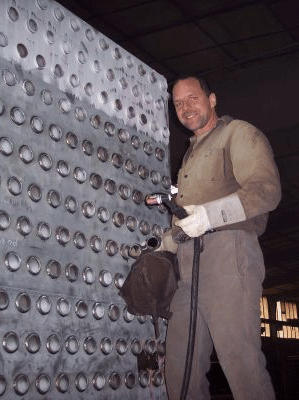 ATT
PROVIDES ULTIMATE CONTROL OF SMALL MANUAL WELDS.
ATT
PROVIDES ULTIMATE CONTROL OF SMALL MANUAL WELDS.
With any alloys in
which small welds or welds on thin gage are required, the ATT process will produce
far superior weld quality to traditional TIG - Plasma - MIG - RMD - CMT - STT
or Pulsed MIG. If manual welding the stainless cooling tubes on the left, you
would typically get the best manual weld quality from the conventional TIG process.
The pulsed MIG process would produce welds in which the weld tie-ins and fusion
would occasionally be suspect and the manual weld appearance would be irregular.
The manual TIG welder on this application, would be feeding slow, inconsistent
wire feed rates with weld current compatible with the wire feed. The inconsistency
of the slow, manual wire feed rate and the individual techniques and differnt
wire feed rates from each welder, would typically be indicated in irregular external
weld appearance and in the internal weld quality attained.
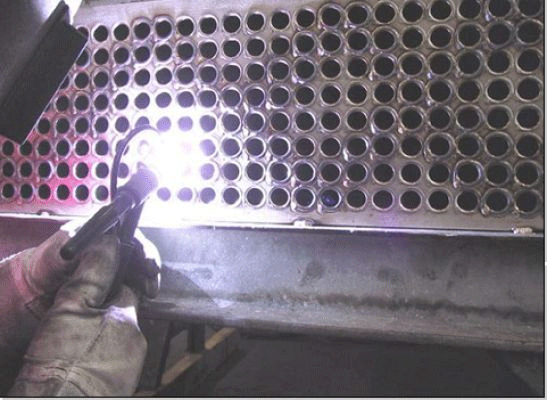
For
these manual welds, the easy to use ATT manual process enables if the welder wishes,
to use two hands to provide ultimate manual control of the torch on the small
round parts. This welder will also use a controlled, fixed wire feed rate that
will enable these welds to be done four to six times faster than regular TIG.
The high wire feed rate enables higher current. The high weld current with the
controlled wire feed and consistent wire to tungsten / arc placement, provides
superior welds than traditional TIG and pulsed MIG.
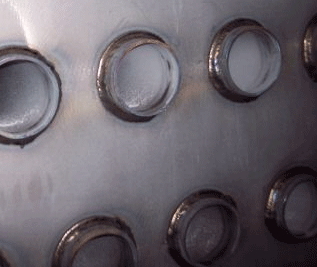 Take
a close look at the stainless ATT manual welds on the left. These welds
were made four times faster than conventional TIG and thanks to the higher weld
energy, controlled wire feed, exact wire to tungsten / arc placement and less
arc starts, the manual ATT weld will always provide much greater weld quality
than any TIG or pulsed MIG weld.
Take
a close look at the stainless ATT manual welds on the left. These welds
were made four times faster than conventional TIG and thanks to the higher weld
energy, controlled wire feed, exact wire to tungsten / arc placement and less
arc starts, the manual ATT weld will always provide much greater weld quality
than any TIG or pulsed MIG weld.
Also note the minimal weld heat affected
zones, this is a great benefit for those concerned with controlling weld distortion
and weld appearence. Many experienced weld personnel would look at the ATT manual
welds on the left and believe they were done with an automatic process. The semi
automatic ATT manual process brings this type of weld quality to any manual weld
or clad weld it produces. ATT is the only manual process that can provide the
weld quality typically attained from automated welds.
SMALL
WELDS OR BIG WELDS THE ATT BENEFITS ARE EXTENSIVE.
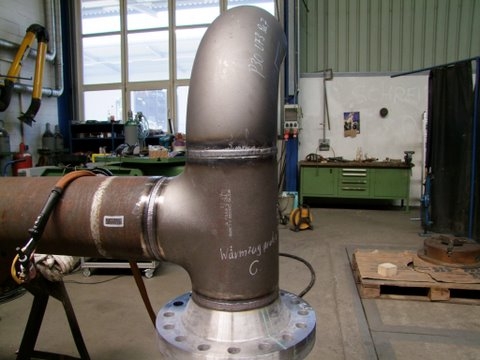
With
traditional TIG, it would take 3 plus hours to do each of these
critical pipe
joints. With the ATT process it took 55 minutes to fully
complete each weld
joint shown and of course these were defect free welds.
CONVENTIONAL
PIPE WELDS, OPTIONS AND CONSIDERATIONS:
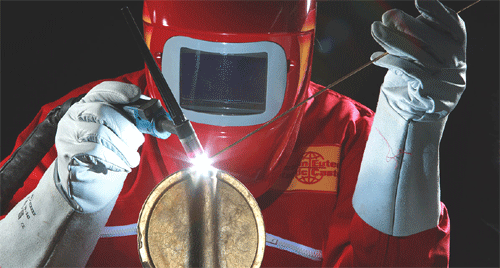 Manual
Pipe Welds: Every
company that has to produce code quality pipe and pressure vessel welds, is aware
that when manual welding, the conventional TIG process has in the past been the
first choice for to attain code quality welds with minimum weld rework. These
same companies will also often be frustrated that the manual TIG process is painfully
slow and the process requires a high degree of skill and dexterity to work the
torch and feed the weld wire. The manual TIG requirements will lead to irregularities
in the welds and finding welders with TIG skills becomes more difficult each year.
Manual
Pipe Welds: Every
company that has to produce code quality pipe and pressure vessel welds, is aware
that when manual welding, the conventional TIG process has in the past been the
first choice for to attain code quality welds with minimum weld rework. These
same companies will also often be frustrated that the manual TIG process is painfully
slow and the process requires a high degree of skill and dexterity to work the
torch and feed the weld wire. The manual TIG requirements will lead to irregularities
in the welds and finding welders with TIG skills becomes more difficult each year.
When
10 welders use traditional TIG and all weld the same all position weld joints,
each TIG welder will use a different weld technique in which the TIG weld wire
is directed at different feed rates into different locations in the TIG arc plasma.
Also the typical TIG pipe weld current used by the manual TIG welders is restricted
by how fast the welder can manually feed the TIG wire from their fingers to the
welds. The resulting TIG weld differences will be noted in the pipe weld appearance
and weld quality attained. Yet even with these differences, the traditional TIG
process has been the process of choice when quality welds are required.